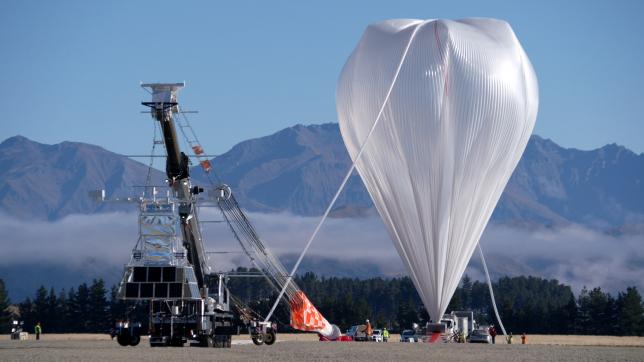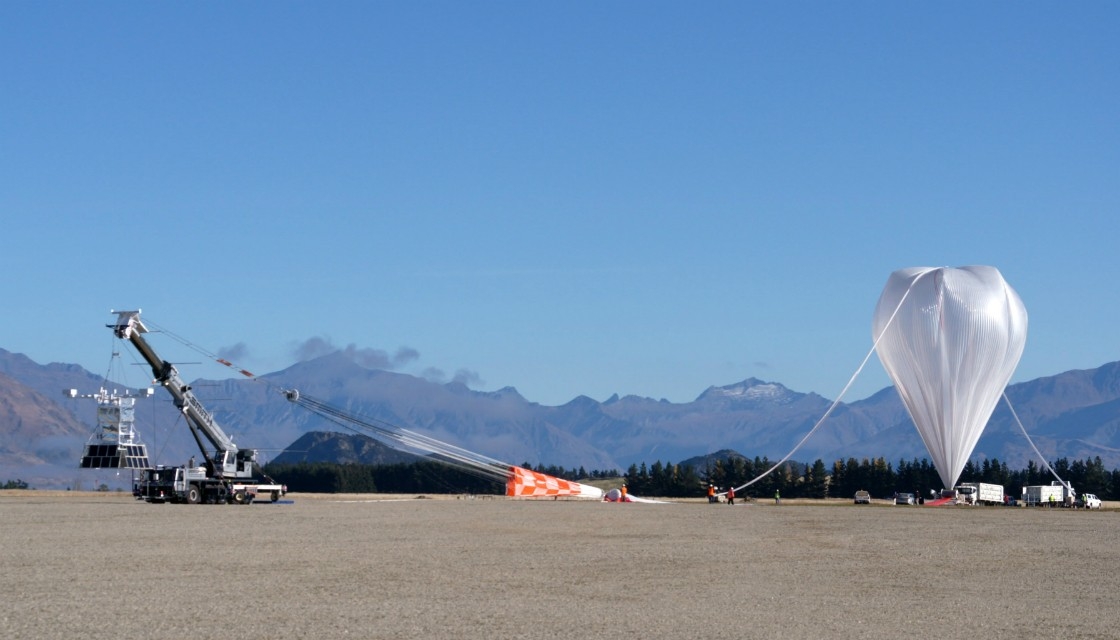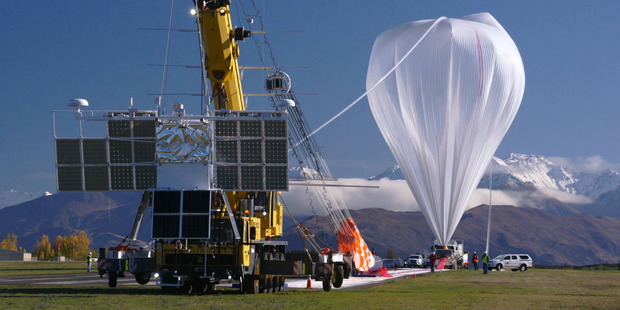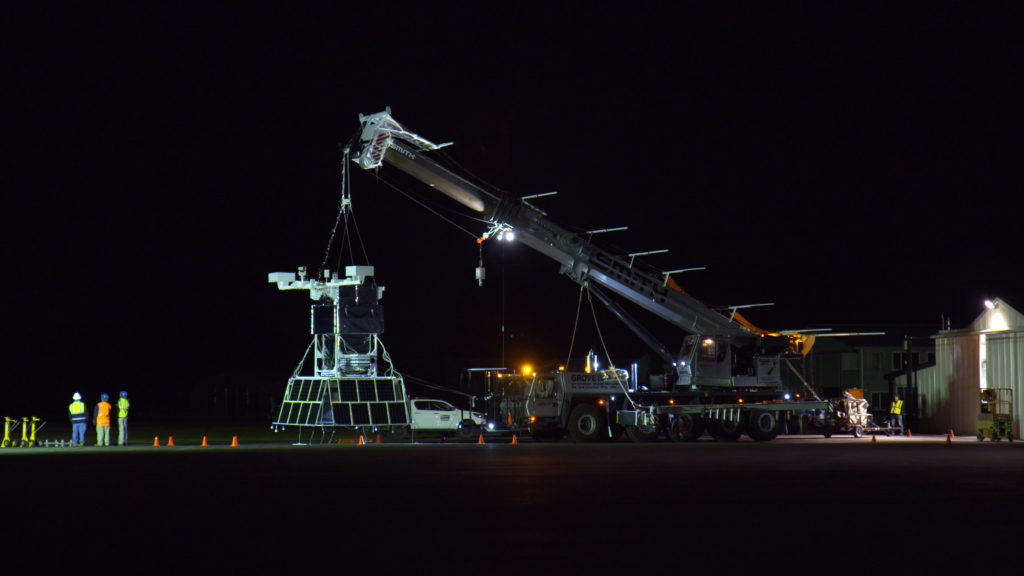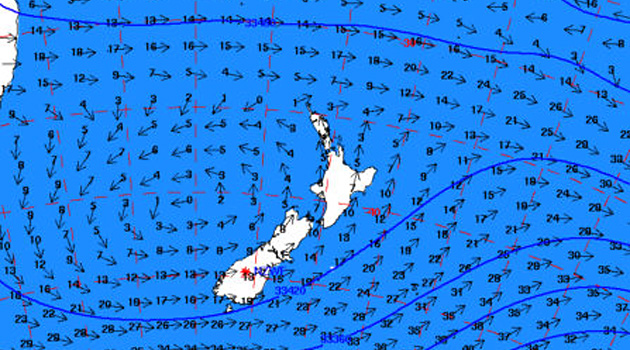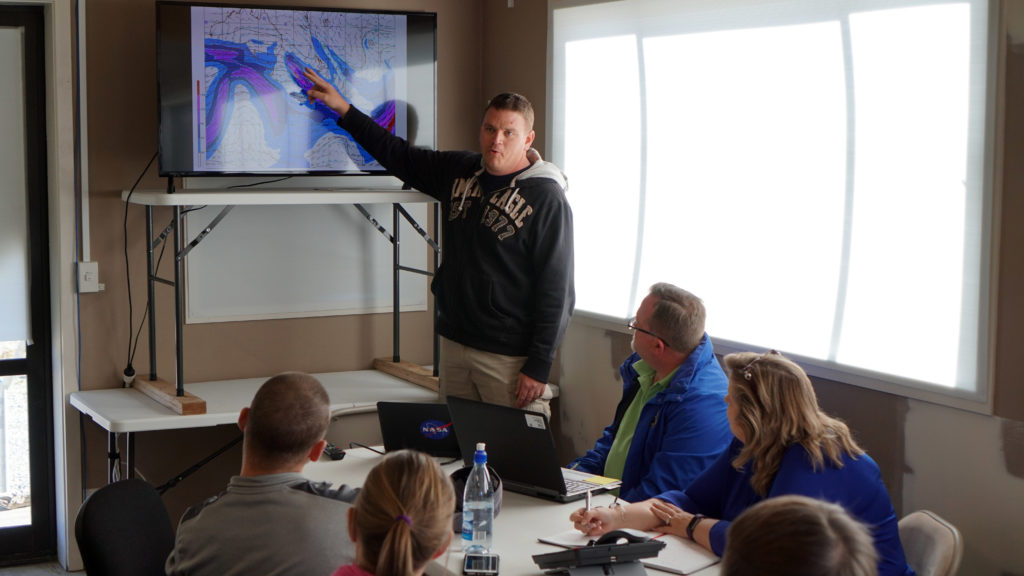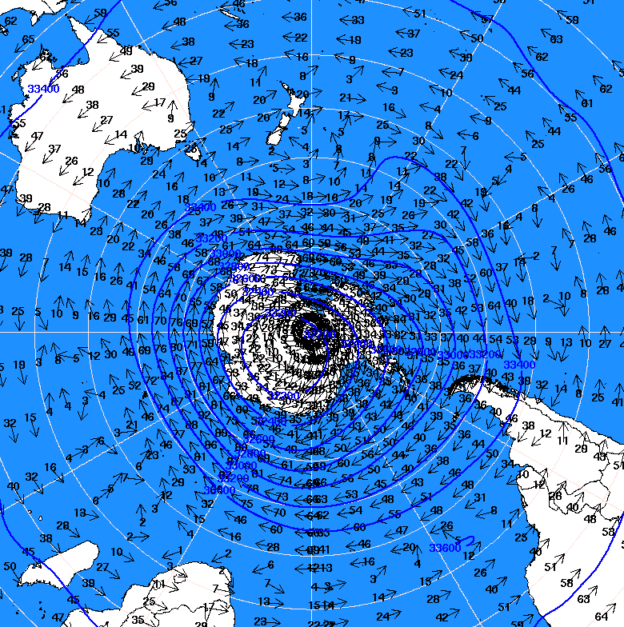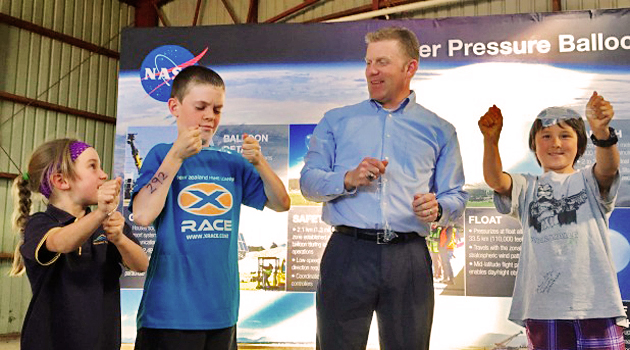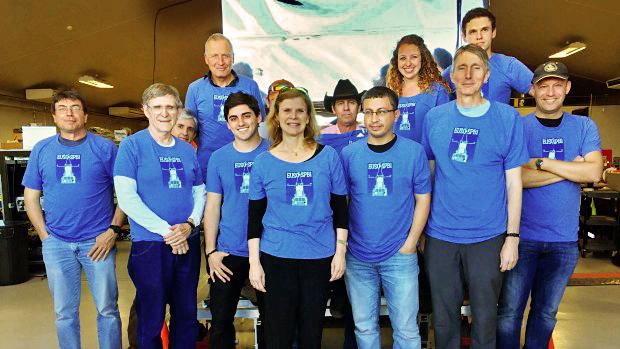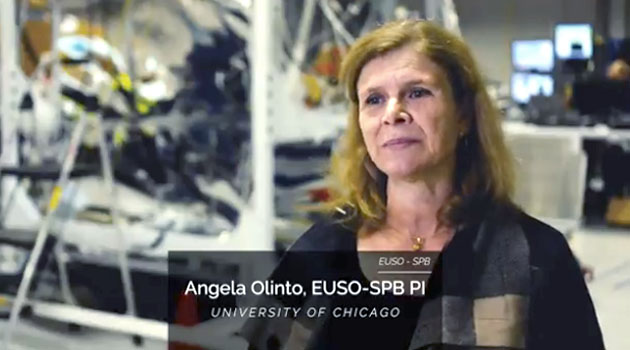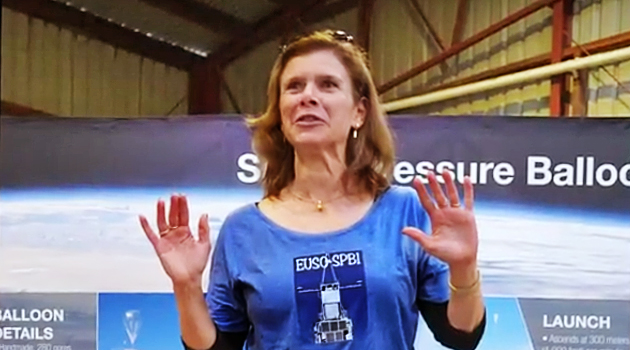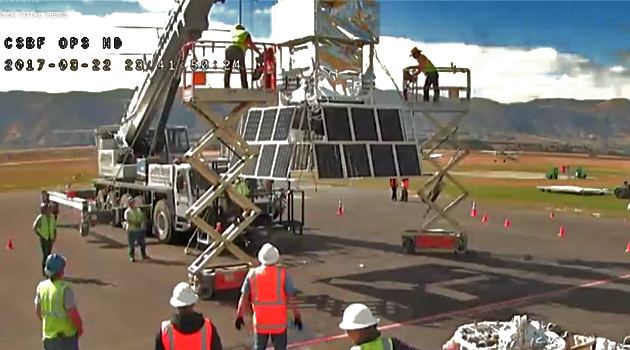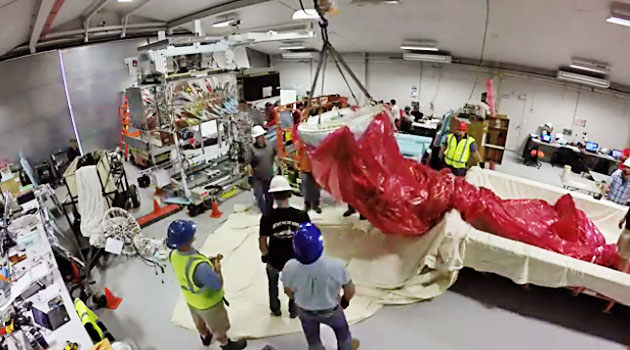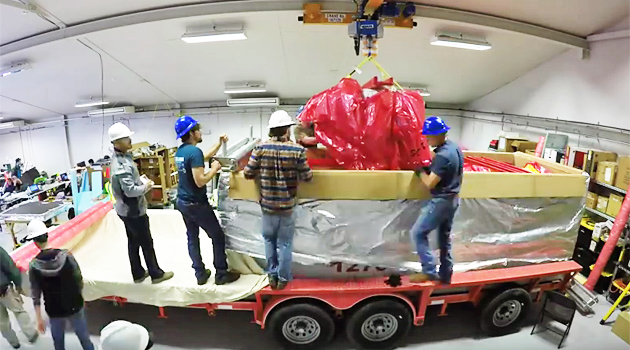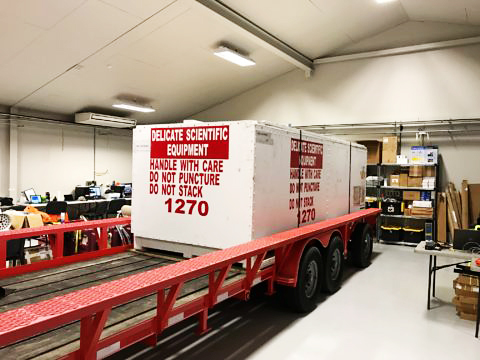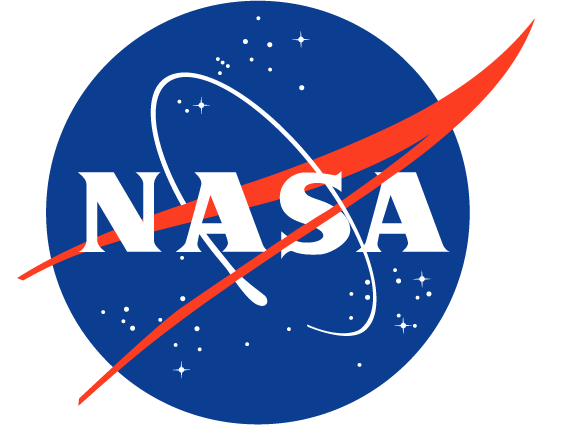| Home | Overview | Science | Instrument | Follow | Collaboration | Publications | Highlights | Photos | JEM-EUSO | UChicago |
EUSO-SPB
|
EUSO-SPB1
NASA Completes Balloon Technology Test Flight May 6, 2017 by Jeremy Eggers NASA completed its third mid-latitude Super Pressure Balloon (SPB) flight at 11:24 p.m. EDT, Saturday, May 6, after 12 days, 4 hours and 34 minutes aloft. Flight controllers at NASA’s Columbia Scientific Balloon Facility in Palestine, Texas, conducted a controlled flight termination of the balloon, which slowly descended back to Earth impacting in the South Pacific Ocean about 200 miles south of Easter Island. Launching from Wanaka Airport, New Zealand, on a mission to test the SPB technology, a leak in the balloon was confirmed on its third day of flight. The balloon was designed to float at a stable altitude of about 33.2 km (109,000 feet) for long durations despite the heating and cooling of the day/night cycle. The balloon started experiencing significant altitude drops at night when the temperature dropped, regaining its predicted altitude during the day as the temperature rose. Flight controllers dropped ballast to manage altitude loss during cold storms, which can see atmospheric temperatures at -50 degrees and below. In the 11th day of flight, the team was left with just 74 pounds of ballast and still 2,000 miles away from South America. Facing a poor weather forecast that would lead to even lower altitudes with little ballast remaining, NASA preemptively ended the flight to ensure the greatest level of control and safety during descent. “It’s unfortunate that our flight has come to an end at this point—our goal was at least two weeks and our hope was for many more weeks beyond that,” said Debbie Fairbrother, NASA’s Balloon Program Office chief. “We were able to collect a great amount of flight data, however, which we’ll analyze in the coming weeks and months to see if we can determine a cause for the leak. We’ll apply lessons learned to future flights as we continue to develop this technology.” Flying on this year’s SPB test flight was the International Extreme Universe Space Observatory-SPB payload. EUSO-SPB is a high-energy cosmic ray particle astrophysics payload testing a fluorescence detector and its supporting technologies under the severe operating conditions of the stratosphere. “The international EUSO Collaboration is deeply thankful for the support, expertise, and dedication of NASA to this historic opportunity to open a new window onto the universe,” said Angela V. Olinto, professor at the University of Chicago and principal investigator (PI) of the project. “Our flight was cut short, but we are confident that the super pressure balloon approach to observing the most energetic cosmic particles will pioneer a new understanding of these extreme phenomena.” “EUSO-SPB performed well, and more than 60 GB of data was downloaded to ground,'' said, Lawrence Wiencke, professor at the Colorado School of Mines and deputy PI for the EUSO-SPB flight. ''We are looking forward to analyzing the data and to another super pressure balloon flight with NASA.” NASA conducted a thorough environmental analysis of an open-ocean landing before beginning its mid-latitude SPB flight program in 2015. The open-ocean flight termination procedure makes use of the two-ton flight payload as an anchor to pull the entire balloon flight train to the bottom of the ocean as quickly as possible. In this way, the balloon does not remain in the primary water column zone where most marine species are known to live, minimizing environmental impacts. NASA’s Wallops Flight Facility in Virginia manages the agency’s scientific balloon flight program with 10 to 15 flights each year from launch sites worldwide. Orbital ATK, which operates NASA’s Columbia Scientific Balloon Facility in Palestine, Texas, provides mission planning, engineering services and field operations for NASA’s scientific balloon program. The CSBF team has launched more than 1,700 scientific balloons in the over 35 years of operation. A Cosmic-Ray Hunter Takes to the Sky by Natalie Wolchover, Quanta Magazine Angela Olinto's new balloon experiment takes her one step closer to the unknown source of the most energetic particles in the universe. In April 25, at 10:50 a.m. local time, a white helium balloon ascended from Wanaka, New Zealand, and lifted Angela Olinto’s hopes into the stratosphere. The football stadium-size NASA balloon, now floating 20 miles above the Earth, carries a one-ton detector that Olinto helped design and see off the ground. Every moonless night for the next few months, it will peer out at the dark curve of the Earth, hunting for the fluorescent streaks of mystery particles called ''ultrahigh-energy cosmic rays'' crashing into the sky. The Extreme Universe Space Observatory Super Pressure Balloon (EUSO-SPB) experiment will be the first ever to record the ultraviolet light from these rare events by looking down at the atmosphere instead of up. The wider field of view will allow it to detect the streaks at a faster rate than previous, ground-based experiments, which Olinto hopes will be the key to finally figuring out the particles’ origin. Olinto, the leader of the seven-country EUSO-SPB experiment, is a professor of astrophysics at the University of Chicago. She grew up in Brazil and recalls that during her ''beach days in Rio'' she often wondered about nature. Over the 40 years since she was 16, Olinto said, she has remained captivated by the combined power of mathematics and experiments to explain the universe. ''Many people think of physics as hard; I find it so elegant, and so simple compared to literature, which is really amazing, but it’s so varied that it's infinite,'' she said. ''We have four forces of nature, and everything can be done mathematically. Nobody's opinions matter, which I like very much!'' Olinto has spent the last 22 years theorizing about ultrahigh-energy cosmic rays. Composed of single protons or heavier atomic nuclei, they pack within quantum proportions as much energy as baseballs or bowling balls, and hurtle through space many millions of times more energetically than particles at the Large Hadron Collider, the world's most powerful accelerator. ''They're so energetic that theorists like me have a hard time coming up with something in nature that could reach those energies,'' Olinto said. ''If we didn't observe these cosmic rays, we wouldn't believe they actually would be produced.'' Olinto and her collaborators have proposed that ultrahigh-energy cosmic rays could be emitted by newly born, rapidly rotating neutron stars, called “pulsars.'' She calls these ''the little guys,'' since their main competitors are ''the big guys'': the supermassive black holes that churn at the centers of active galaxies. But no one knows which theory is right, or if it's something else entirely. Ultrahigh-energy cosmic rays pepper Earth so sparsely and haphazardly - their paths skewed by the galaxy's magnetic field - that they leave few clues about their origin. In recent years, a hazy ''hot spot'' of the particles coming from a region in the Northern sky seems to be showing up in data collected by the Telescope Array in Utah. But this potential clue has only compounded the puzzle: Somehow, the alleged hot spot doesn't spill over at all into the field of view of the much larger and more powerful Pierre Auger Observatory in Argentina. To find out the origin of ultrahigh-energy cosmic rays, Olinto and her colleagues need enough data to produce a map of where in the sky the particles come from - a map that can be compared with the locations of known cosmological objects. ''In the cosmic ray world, the big dream is to point,'' she said during an interview at a January meeting of the American Physical Society in Washington, D.C. She sees the current balloon flight as a necessary next step. If successful, it will serve as a proof of principle for future space-based ultrahigh-energy cosmic-ray experiments, such as her proposed satellite detector, Poemma (Probe of Extreme Multi-Messenger Astrophysics). While in New Zealand in late March preparing for the balloon launch, Olinto received the good news from NASA that Poemma had been selected for further study. Olinto wants answers, and she has an ambitious timeline for getting them. An edited and condensed version of our conversations in Washington and on a phone call to New Zealand follows. QUANTA MAGAZINE: What was your path to astrophysics and ultrahigh-energy cosmic rays? ANGELA OLINTO: I was really interested in the basic workings of nature: Why three families of quarks? What is the unified theory of everything? But I realized how many easier questions we have in astrophysics: that you could actually take a lifetime and go answer them. Graduate school at MIT showed me the way to astrophysics - how it can be an amazing route to many questions, including how the universe looks, how it functions, and even particle physics questions. I didn't plan to study ultrahigh-energy cosmic rays; but every step it was, ''OK, it looks promising.'' QUANTA MAGAZINE: How long have you been trying to answer this particular question? ANGELA OLINTO: In 1995, we had a study group at Fermilab for ultrahigh-energy cosmic rays, because the AGASA (Akeno Giant Air Shower Array) experiment was seeing these amazing events that were so energetic that the particles broke a predicted energy limit known as the ''GZK cutoff.'' I was studying magnetic fields at the time, and so Jim Cronin, who just passed away last year in August - he was a brilliant man, charismatic, full of energy, lovely man - he asked that I explain what we know about cosmic magnetic fields. At that time the answer was not very much, but I gave him what we did know. And because he invited me I got to learn what he was up to. And I thought, wow, this is pretty interesting. QUANTA MAGAZINE: Later you helped plan and run Pierre Auger, an array of detectors spread across 3,000 square kilometers of Argentinian grassland. Did you actually go around and persuade farmers to let you put detectors on their land? ANGELA OLINTO: Not me; it was the Argentinian team who did the amazing job of talking to everybody. The American team helped build a planetarium and a school in that area, so we did interact with them, but not directly on negotiations over land. In Argentina it was like this: You get a big fraction of folks who are very excited and part of it from the beginning. Gradually you got through the big landowners. But eventually we had a couple who were really not interested. So we had two regions in the middle of the array that were empty of the detectors for quite some time, and then we finally closed it. Space is much easier in that sense; it's one instrument and no one owns the atmosphere. On the other hand, the nice thing about having all the farmers involved is that Malargue, the city in Argentina that has had the detectors deployed, has changed completely. The students are much more connected to the world and speak English. Some are coming to the U.S. for undergraduate and even graduate school eventually. It's been a major transformation for a small town where nobody went to college before. So that was pretty amazing. It took a huge outreach effort and a lot of time, but this was very important, because we needed them to let us in. QUANTA MAGAZINE: Why is space the next step? ANGELA OLINTO: To go the next step on the ground - to get 30,000 square kilometers instrumented - is something I tried to do, but it's really difficult. It's hard enough with 3,000; it was crazy to begin with, but we did it. To get to the next order of magnitude seems really difficult. On the other hand, going to space you can see 100 times more volume of air in the same minute. And then we can increase by orders of magnitude the ability to see ultrahigh-energy cosmic rays, see where they are coming from, how they are produced, what objects can reach these kinds of energies. QUANTA MAGAZINE: What will we learn from EUSO-SPB? ANGELA OLINTO: We will not have enough data to revolutionize our understanding at this point, but we will show how it can be done from space. The work we do with the balloon is really in preparation for something like Poemma, our proposed satellite experiment. We plan to have two telescopes free-flying and communicating with each other, and by recording cosmic-ray events with both of the them we should be able to also reproduce the direction and composition very precisely. QUANTA MAGAZINE: Speaking of Poemma, do you still teach a class called Cosmology for Poets? ANGELA OLINTO: We don't call it that anymore, but yes. What it entails is teaching nonscience majors what we know about the history of the universe: what we've learned and why we think it is the way it is, how we measure things and how our scientific understanding of the history of the universe is now pretty interesting. First, we have a story that works brilliantly, and second, we have all kinds of puzzles like dark matter and dark energy that are yet to be understood. So it gives the sense of the huge progress since I started looking at this. It's unbelievable; in my lifetime it's changed completely, and mostly due to amazing detections and observations. One thing I try to do in this course is to mix in some art. I tell them to go to a museum and choose an object or art piece that tells you something about the universe - that connects to what we talked about in class. And here my goal is to just make them dream a bit free from all the boundaries of science. In science there's right and wrong, but in art there are no easy right and wrong answers. I want them to see if they can have a personal attachment to the story I told them. And I think art helps me do that. QUANTA MAGAZINE: You’ve said that when you left Brazil for MIT at 21, you were suffering from a serious muscle disease called polymyositis, which also recurred in 2006. Did those experiences contribute to your drive to push the field forward? ANGELA OLINTO: I think this helps me not get worked up about small stuff. There are always many reasons to give up when working on high-risk research. I see some colleagues who get worked up about things that I'm like, whatever, let's just keep going. And I think that attitude to minimize things that are not that big has to do with being close to death. Being that close, it's like, well, everything is positive. I'm very much a positive person and most of the time say, let's keep pushing. I think having a question that is not answered that is well posed is a very good incentive to keep moving. QUANTA MAGAZINE: Between the ''big guys'' and the ''little guys'' - black holes versus pulsating neutron stars - what's your bet for which ones produce ultrahigh-energy cosmic rays? ANGELA OLINTO: I think it's 50-50 at this point - both can do it and there's no showstopper on either side - but I root always for the underdog. It looks like ultrahigh-energy cosmic rays have a heavier composition, which helps the neutron star case, since we had heavy elements in our neutron star models from the beginning. However, it's possible that supermassive black holes do the job, too, and basically folks just imagine that the bigger the better, so the supermassive black holes are usually a little bit ahead. It could be somewhere in the middle: intermediate-mass black holes. Or ultrahigh-energy cosmic rays could be related to other interesting phenomena, like fast radio bursts, or something that we don't know anything about. QUANTA MAGAZINE: When do you think we'll know for sure? ANGELA OLINTO: You know how when you climb the mountain - I rarely look at where I'm going. I look at the next two steps. I know I’m going to the top but I don't look at the top, because it's difficult to do small steps when the road is really long. So I don't try to predict exactly. But I would imagine - we have a decadal survey process, so that takes quite some time, and then we have another decade - so let’s say, in the 2030s we should know the answer. Eighth time lucky: NASA launches super balloon to collect near space data Reuters, by Charlotte Greenfield NASA's Super Pressure Balloon stands fully inflated and ready for lift-off from Wanaka Airport, New Zealand before it took flight at 10:50 a.m. local time April 25, 2017 (1850 EDT April 24, 2017.) Bill Rodman/Courtesy NASA A stadium-sized pressure balloon launched by NASA in New Zealand began collecting data in near space on Wednesday, beginning a 100-day planned journey after several launch attempts were thwarted by storms and cyclones.The balloon, designed by the National Aeronautics and Space Administration (NASA) to detect ultra-high energy cosmic particles from beyond the galaxy as they penetrate the earth's atmosphere, is expected to circle the planet two or three times. ''The origin of these particles is a great mystery that we'd like to solve. Do they come from massive black holes at the centre of galaxies? Tiny, fast-spinning stars? Or somewhere else?'' Angela Olinto, a University of Chicago professor and lead investigator on the project, said in a statement. The balloon's monitoring was only the start of a long quest which would next involve a space mission currently being designed by NASA, she added. The balloon, launched on Tuesday in Wanaka, a scenic spot on New Zealand's South Island, will collect data from 34 km (21.1 miles) above the earth. New Zealand was also the base for NASA's scientific balloon program in 2015 and 2016. UChicago-led NASA balloon mission launches, with goal of breaking flight record by Greg Borzo, UChicago News NASA's super-pressure balloon took flight at 10:50 a.m. local time April 25 (5:50 p.m. CST April 24) from Wanaka Airport in New Zealand. Scientists hope the balloon will stay afloat for up to 100 days, more than doubling the previous flight record of 46 days. Prof. Angela Olinto hopes telescope will help unravel mysteries of cosmic raysNASA on April 24 launched a football-stadium-sized, super-pressure balloon on a mission that aims to set a record for flight duration while carrying a telescope that scientists at the University of Chicago and around the world will use to study cosmic rays. Researchers from 16 nations hope the balloon, which lifted off from an airfield in Wanaka, New Zealand, will stay afloat for up to 100 days as it travels at 110,000 feet around the Southern Hemisphere. From its vantage point in near-space, the telescope is designed to detect ultra-high energy cosmic rays as they penetrate the Earth's atmosphere. An ultraviolet camera on the telescope will take 400,000 images a second as it looks back toward Earth to try and capture some of the particles. ''The mission is searching for the most energetic cosmic particles ever observed,'' said Angela V. Olinto, the Homer J. Livingston Distinguished Service Professor at the University of Chicago and principal investigator of the project, known as the Extreme Universe Space Observatory on a Super Pressure Balloon (EUSO-SPB). ''The origin of these particles is a great mystery that we'd like to solve. Do they come from massive black holes at the center of galaxies? Tiny, fast-spinning stars? Or somewhere else?'' The next step for Olinto and her fellow scientists is a space mission, now being designed by NASA centers under her leadership, to observe a greater atmospheric area for detecting high-energy cosmic rays and neutrinos. These extremely rare particles hit the atmosphere at a rate of only one per square kilometer per century. As the NASA balloon travels around the Earth in the coming months, it may be visible from the ground, particularly at sunrise and sunset, to those who live in the mid-latitudes of the Southern Hemisphere such as Australia, Argentina and South Africa. The complex balloon launch depended on the right weather conditions on the surface of the Earth all the way up to 110,000 feet, where the balloon travels. The launch window for lift-off opened March 25, and it a full month until the 18.8-million-cubic-foot balloon could take flight. Scientists now hope the balloon, made of a polyethylene film stronger and more durable than the type used in sandwich bags, can break the previous flight record of 46 days, set in 2016. At a relatively low cost, NASA's heavy-lift balloons have become critical launch vehicles for testing new technologies and science instruments to assure success for costlier, higher-risk spaceflight missions, said Debbie Fairbrother, chief of NASA's Balloon Program Office. ''For decades, balloons have provided access to the near-space environment to support scientific investigations, technology testing, education and workforce development,'' Fairbrother said. ''We're thrilled to provide this high-altitude flight opportunity for EUSO-SPB as they work to validate their technologies while conducting some really mind-blowing science.'' Balloons also are part of UChicago's storied history of cosmic ray research, which dates to 1928 when Nobel laureate Robert Millikan first coined the term in a research paper. Pierre Auger, the namesake of the cosmic ray observatory in Argentina, launched hot air balloon experiments in the 1940s from the former site of Stagg Field. UChicago scientists used balloons in the Arctic Circle to discover positrons (the anti-particles of electrons) in the 1960s. The EUSO-SPB project includes two UChicago undergraduates, Leo Allen and Mikhail Rezazadeh, who built an infrared camera under the supervision of Olinto and Stephan Meyer, professor of astronomy and astrophysics, to observe the cloud coverage at night. Sixteen countries were involved with the design of the telescope and construction involved the U.S., France, Italy, Germany, Poland, Mexico and Japan. The U.S. team, funded by NASA, is led by UChicago, with co-investigators at Colorado School of Mines, Marshall Space Flight Center, University of Alabama at Huntsville and Lehman College at the City University of New York. NASA's Super Pressure Balloon Takes Flight From New Zealand Posted April 24, 2017 by Jeremy Eggers NASA's Super Pressure Balloon stands fully inflated and ready for lift-off from Wanaka Airport, New Zealand. The balloon took flight at 10:50 a.m. local time April 25 (6:50 p.m. April 24 in U.S. Eastern Time). NASA successfully launched its football-stadium-sized, heavy-lift super pressure balloon (SPB) from Wanaka, New Zealand, at 10:50 a.m. Tuesday, April 25 (6:50 p.m. April 24 in U.S. Eastern Time), on a mission designed to run 100 or more days floating at 110,000 feet (33.5 km) about the globe in the southern hemisphere's mid-latitude band.Credits: NASA/Bill Rodman ''Following our 2015 and 2016 New Zealand missions, we've learned key lessons on the balloon design that have gone into perfecting the technology for this year's flight,'' said Debbie Fairbrother, NASA's Balloon Program Office chief. ''I'm very proud of the team that delivered us to this point and I'm hopeful that third time's the charm for realizing 100 days of flight.'' While validating the super pressure balloon technology is the main flight objective, the International Extreme Universe Space Observatory on a Super Pressure Balloon (EUSO-SPB) payload is flying as a mission of opportunity. Also flying on the payload is a poppy in commemoration of Anzac Day, a national day of remembrance in New Zealand and Australia similar in spirit to the U.S. observance of Memorial Day. EUSO-SPB's objective is to detect ultra-high energy cosmic rays from beyond our galaxy as they penetrate the Earth's atmosphere. As these high-energy particles enter the atmosphere, they interact with nitrogen molecules in the air and create a UV fluorescence light. From its high-altitude vantage point, EUSO-SPB will look downward observing a broad swathe of the Earth’s atmosphere to detect the UV fluorescence from these deep space cosmic rays coming in from above. ''EUSO-SPB is now searching for the most energetic cosmic particles ever observed,'' said Angela V. Olinto, professor at the University of Chicago and principal investigator of the project. ''The origin of these particles is a great mystery that our pioneering mission will help to solve. Do they come from massive black holes at the center of galaxies? Tiny, fast-spinning pulsars? Or somewhere else?'' ''The international science team is very excited to see our cosmic ray fluorescence detector lifted to suborbital space by this remarkable balloon and departing on this global journey,'' said Lawrence Wiencke, professor at the Colorado School of Mines and deputy principal investigator. ''This balloon will give us a great view, and we are hoping for a record flight. We would especially like to thank the NASA and Columbia Scientific Balloon Facility teams for their patience, hard work, and extensive expertise that made this launch successful.'' At a relatively low cost, NASA's heavy-lift balloons have been critical launch vehicles for testing and validating new technologies and science instruments to assure mission success for costlier, higher-risk follow-on spaceflight missions, said Fairbrother. Once the technology is validated, the ultimate goal of the EUSO project is to fly from an even higher altitude on the International Space Station to observe a greater atmospheric area for detecting high-energy cosmic rays. ''We are proud to once again support NASA's scientific balloon program by demonstrating the experience and dedication needed to execute scientific balloon operations,” said John Pullen, Vice President and General Manager, Technical Services Division of Orbital ATK's Space Systems Group. ''The NASA/Orbital ATK team continues to deliver affordable and reliable long duration balloon flights across the world from Antarctica to New Zealand to Palestine, Texas home of the Columbia Scientific Balloon Facility. Our flexibility and history of success allow us to launch a variety of balloons that provide critical scientific data for new technologies and discoveries no matter the location.'' The 18.8-million-cubic-foot (532,000-cubic-meter) Super Pressure Balloon lifted off from NASA's new launch pad adjacent to Wanaka Airport carrying a suspended payload of 5,500 pounds (2,495 kilograms). The new pad along with a recently established 10-year lease with Queenstown Airport Corporation are key developments for enhancing NASA's mid-latitude, long-duration balloon flight operations in New Zealand. According to Fairbrother, future investments include a payload processing facility on-site. ''It's been a huge privilege and honor to have the NASA and SPB team back again for a third year in Wanaka,'' said Ralph Fegan, Wanaka Airport operations manager. ''The team here at Wanaka and Queenstown Airports are excited to see what the next 10 years bring as the relationship between us grows.'' As the balloon travels around the Earth, it may be visible from the ground, particularly at sunrise and sunset, to those who live in the southern hemisphere’s mid-latitudes, such as Argentina and South Africa. Anyone may track the progress of the flight, which includes a map showing the balloon's real-time location. NASA’s Wallops Flight Facility in Virginia manages the agency’s scientific balloon flight program with 10 to 15 flights each year from launch sites worldwide. Orbital ATK, which operates NASA's Columbia Scientific Balloon Facility in Palestine, Texas, provides mission planning, engineering services and field operations for NASA's scientific balloon program. The CSBF team has launched more than 1,700 scientific balloons in the over 35 years of operation. NASA balloon takes off from Wanaka A poppy is flying on the payload of NASA's super-pressure balloon, which has launched from Wanaka Airport on its eighth attempt. The balloon, which will inflate to the size of a football stadium, left the ground at 10.50am on Anzac Day. The previous attempts, the last of which was on Saturday, were called off because of unfavourable winds. The balloon is designed to run for 100 or more days, floating more than 33km above the Southern Hemisphere's mid-latitude band. NASA balloon programme office chief Debbie Fairbrother says validating the super pressure balloon technology is the flight's main objective. She says key lessons have been learnt from the 2015 and 2016 flights that launched from Wanaka. It is also a mission of opportunity for the International Extreme Universe Space Observatory on a Super Pressure Balloon (EUSO-SPB) payload. EUSO-SPB's objective from a high-altitude vantage point is to detect ultra-high energy cosmic rays from beyond the galaxy as they penetrate the Earth's atmosphere. As the high-energy particles enter the atmosphere, they interact with nitrogen molecules in the air and create a UV fluorescence light. The project's principal investigator, Chicago University professor Angela Olinto, says EUSO-SPB is searching for the most energetic cosmic particles ever observed. ''The origin of these particles is a great mystery that our pioneering mission will help to solve,'' she said. ''Do they come from massive black holes at the centre of galaxies? Tiny, fast-spinning pulsars? Or somewhere else?'' NASA launches super pressure balloon in Wanaka A stadium-sized balloon launch conducted by Nasa is going ahead in Wanaka after seven failed attempts. Nasa will be conducting a super-pressure balloon test flight from Wanaka on a planned 100-day journey. If the weather is conducive, lift-off is scheduled between 9.30am and 11.30am. It will be the eighth scheduled launch attempt. The balloon inflates to 18.8 million cubic feet, about the size of Dunedin's Forsyth Barr Stadium. The balloon is made from polyethylene film, which is similar in appearance and thickness to the type used for sandwich bags, but stronger and more durable. After launch the balloon will ascend to an altitude of 33.5 kilometres where the stratospheric winds will propel it at speeds of at least 100 knots through the heating and cooling of the day-night cycle on a weeks-long journey around the Southern Hemisphere, said Debbie Fairbrother, Nasa's Balloon Programme Office chief. Unfavourable weather conditions meant the last seven attempts to launch the balloon had been unsuccessful. The balloon will be collecting scientific data from what NASA describes as ''near space''. Wanaka Airport, NZ—NASA’s Mid-Latitude Super Pressure Balloon Launch Site Posted on April 20, 2017 at 2:18 pm by Jeremy Eggers Learn more about Wanaka Airport, New Zealand, one of the busiest, most diverse-use airspaces around. In this video, Ralph Fegan, Wanaka Airport Operations Manager, talks about the different activities at the airport and what NASA’s Super Pressure Balloon project has brought to the area. Low Pressure System Thwarts Super Pressure Launch Efforts posted on April 10, 2017 at 9:07 pm by Jeremy Eggers The International Extreme Universe Space Observatory-Super Pressure Balloon payload is picked up and prepared for flight during a launch attempt April 10 from Wanaka Airport, New Zealand. NASA conducted three super pressure balloon launch attempts April 8 – 10 (New Zealand time), but had to stand down each day for various reasons related to weather, forecast trajectories, and maintenance. (NASA/Bill Rodman) Multiple areas of low pressure with associated precipitation and unfavorable winds have settled in over New Zealand preventing NASA from attempting a super pressure balloon launch from Wanaka over the next several days.“Conditions do not look favorable for the next four to five days given the winds, forecast rain, and uncertainties with Tropical Cyclone Cook to the northwest of us,” said Chris Schwantes, NASA’s on-site meteorologist for the 2017 Wanaka Super Pressure Balloon Campaign. “However, forecast models currently show high pressure building up in the area after the Easter weekend, which could lead to favorable conditions for launching.” Since declaring flight readiness March 25, NASA has conducted three launch attempts for its super pressure balloon. The first of the three back-to-back attempts began April 8 (New Zealand time zone), ending early due to uncertainty with the balloon trajectory given forecast stratospheric wind conditions at 33.5 km (110,000 feet), the balloon’s planned float altitude. The second attempt, April 9, also ended early due to mechanical issues with NASA’s launch vehicle crane—issues that have since been resolved. The third attempt progressed into the early morning hours of April 10 ending when surface and low-level winds failed to set up as required for launch. “A lot of things need to go right to support a launch attempt, but only one thing needs to go wrong,” said Justin Marsh, campaign manager for the 2017 Wanaka Super Pressure Balloon Campaign. “Our team remains flight ready to support a launch attempt once the weather improves. All things considered, it’s still relatively early in the campaign.” Third Launch Attempt Scheduled for Super Pressure Balloon Posted on April 8, 2017 at 7:30 pm by Jeremy Eggers UPDATE: (4:30 a.m. New Zealand Time). NASA Balloon Launch Attempt Postponed Due to Weather NASA postponed the third launch attempt of its super pressure balloon (SPB) from Wanaka, New Zealand, at 4:30 a.m. Monday, April 10 (New Zealand time) due to poor weather at ground and surface levels. Wind speeds were just slightly above those required for launch, and with the uncertainty for precipitation in the area, the team made the decision to postpone for the day. No launch attempt is scheduled for Tuesday, April 11. NASA will announce by 2 p.m. Tuesday, whether or not Wednesday’s weather will support a launch attempt. (All times/dates New Zealand time zone.) -------------------------------------------- NASA is targeting Monday, April 10 (Sunday, April 9 in Eastern Time), to conduct a super pressure balloon (SPB) test flight launching from Wanaka Airport, New Zealand, on a potential 100-day journey. NASA will begin flight preparations in the early morning hours Monday and will continue to evaluate real-time and forecast weather conditions throughout the morning. If weather is conducive for launch, lift-off is scheduled between 8 and 11:30 a.m. locally (between 4 and 7:30 p.m. EDT Sunday, April 9). At this time, weather conditions are considered marginal for launch. “There are periods of light rain forecast tomorrow, but we may have a launch opportunity early in our window,” said Gabe Garde, mission manager for the 2017 Wanaka Balloon Campaign. “In the stratosphere at 33.5 km (110,000 feet), the winds are forecast to take the balloon due east after launch, which is ideal for our operations.” This is the third scheduled launch attempt for NASA’s 2017 Wanaka Balloon Campaign. The first attempt was canceled due to unacceptable stratospheric wind conditions; the second attempt was canceled due to a mechanical issue with a crane used for launch operations, which has since been resolved. The launch can be tracked in the following ways:
NASA Postpones Super Pressure Balloon Launch Posted on April 7, 2017 at 10:45 am by Jeremy Eggers This graphic shows stratospheric wind speed and direction at 33.5 km (110,000 feet), which is the operational altitude of NASA’s Super Pressure Balloon. The eddy pattern to the west of New Zealand led to an unacceptable trajectory forecast to make a launch attempt Saturday, April 8 (New Zealand time zone). NASA postponed the scheduled launch of its super pressure balloon (SPB) from Wanaka, New Zealand, at 2 a.m. Saturday, April 8 (New Zealand time) due to unacceptable stratospheric weather conditions for operations.Along with monitoring ground and lower-level winds (up to 300 meters) on launch day, stratospheric wind conditions at 33.5 km (110,000 feet), which is where the balloon will float, also need to be set-up favorably to support a launch attempt. While ground and lower-level winds were conducive for launch, winds in the stratosphere were not. A counter-clockwise flowing eddy has developed to the west of New Zealand’s North Island. Forecast models had the balloon launching from Wanaka and then traveling north bisecting the South Island before eventually getting caught up in the light and variable winds of the eddy. Ideally, an eastward trajectory after lift-off is preferred, though not necessarily required. “Had the forecast stratospheric models pushed the balloon further west—not unlike what we saw in our 2016 launch—we would have seriously considered moving forward with our launch attempt,” said Gabe Garde, NASA’s mission manager for the balloon launch. “Unfortunately, there’s too much uncertainty in the final trajectory forecast given the nearby eddy pattern in the stratosphere. More opportunities will present themselves as we continue to move forward in the campaign.” NASA will announce by 2 p.m. Saturday, April 8, whether or not Sunday’s weather will support a launch attempt. Launch Attempt Scheduled for Super Pressure Balloon Posted on April 6, 2017 at 7:40 pm by Jeremy Eggers The Compton Spectrometer and Imager (COSI) payload just prior to launch from Wanaka, New Zealand, on a NASA super pressure balloon in May 2016. (NASA/Bill Rodman) NASA is targeting Saturday, April 8 (Friday, April 7 in Eastern Time), to conduct a super pressure balloon (SPB) test flight launching from Wanaka Airport, New Zealand, on a potential 100-day journey.NASA will begin flight preparations in the early morning hours Saturday and will continue to evaluate real-time and forecast weather conditions throughout the morning. If weather is conducive for launch, lift-off is scheduled between 8 and 11:30 a.m. locally (between 4 and 7:30 p.m. EDT Friday, April 7). “At this time, the weather at the ground and lower levels looks very good for a Saturday launch attempt,” said Gabe Garde, mission manager for the 2017 Wanaka Balloon Campaign. “However, we continue to evaluate the forecast stratospheric winds and predicted flight trajectory to ensure conditions are acceptable before launch.” The launch can be tracked in the following ways:
NASA to launch telescope on super-pressure balloon in search for cosmic rays By Greg Borzo, UChicago News, April 5, 2017 Angela V. Olinto, the Homer J. Livingston Distinguished Service Professor at the University of Chicago and principal investigator the 'Extreme Universe Space Observatory-Super Pressure Balloon' project. Prof. Angela Olinto leads project to collect data at near-space altitudesThe National Aeronautics and Space Administration is preparing to use a super-pressure balloon to launch into near space a pioneering telescope designed to detect ultra-high-energy cosmic rays as they interact with the Earth's atmosphere. ''We're searching for the most energetic cosmic particles that we’ve ever observed,'' said Angela V. Olinto, the Homer J. Livingston Distinguished Service Professor at the University of Chicago and principal investigator of the project, known as the Extreme Universe Space Observatory-Super Pressure Balloon. ''The origin of these particles is a great mystery that we'd like to solve. Do they come from massive black holes at the center of galaxies? Tiny, fast-spinning stars? Or somewhere else?'' The extremely rare particles hit the atmosphere at a rate of only one per square kilometer per century. To assure that it will capture some of the particles, the telescope's camera takes 400,000 images a second as it casts a wide view back toward the Earth. Preparations are complete in Wanaka, New Zealand for the balloon's launch, which will happen as soon as scientists and engineers have the right weather conditions. Researchers hope the balloon will stay afloat for up to 100 days, thereby setting a record for an ultra-long duration flight. NASA describes the super-pressure balloon as the ''most persnickety'' of all the flight and launch vehicles it operates. Launching the balloon depends on just the right weather conditions on the surface of the Earth all the way up to 110,000 feet, where the balloon travels. The project will set the stage for a space mission currently being planned. ''That would enlarge even more the volume of the atmosphere that we can observe at one time,'' said Olinto, who serves as chair of UChicago's Department of Astronomy and Astrophysics. ''We need to observe a significantly large number of these cosmic messengers to discover what are their sources and how they interact at their energetic extremes.'' When an ultra-high-energy cosmic ray reaches the Earth's atmosphere, it induces a series of interactions that stimulates a large cosmic ray shower. The new telescope, which detects at night, will capture the ultra-violet fluorescence produced by the interaction of these particle showers with the nitrogen molecules in the air. ''High-energy cosmic rays have never been observed this way from space,'' said Lawrence Wiencke, professor of physics at the Colorado School of Mines and co-leader of the project. ''This mission to a sub-orbital altitude is a pioneering opportunity for us. Our international collaboration is very excited about this launch and about the new data that will be collected along the way.'' The project lends itself to participation by graduate and undergraduate students, Olinto said. Leo Allen and Mikhail Rezazadeh, two UChicago undergraduates, built an infrared camera under the supervision of UChicago Prof. Stephan Meyer and Olinto to observe the cloud coverage at night under EUSO-SPB. Sixteen countries were involved with the design of the telescope. The U.S. team, funded by NASA, is led by UChicago, Colorado School of Mines, Marshall Space Flight Center, University of Alabama at Huntsville and Lehman College at the City University of New York. 'Seal Team 6': Constructing a Super Pressure Balloon Posted on April 5, 2017 at 6:06 pm by Jeremy Eggers Balloon fabricators at Raven Aerostar’s Sulphur Springs, Texas, manufacturing facility reposition balloon material during super pressure balloon construction. As the latest super pressure balloon (SPB) prepares to lift off from New Zealand, carrying the Extreme Universe Space Observatory-SPB (EUSO-SPB) payload, one may reflect back on how this balloon, the 6th iteration in the current model of long duration balloons, came to be and what goes into its construction - acres and acres of plastic film, miles of load-bearing strength members, platforms for electronics, and suspension points for payloads, to name a few.The raw materials and design are only part of it. A balloon of this size cannot simply 'walk into Mordor,' i.e. construction is a difficult task that involves hundreds of film segments. It requires a 'seal team' -- a primary team of six assemblers from Raven Aerostar, NASA’s balloon partner, to shape multiple segments of film into a vehicle that will function at a near constant 33 km altitude, well into the stratosphere, over long durations of day and night cycles. Two Raven Aerostar assemblers are dedicated to operating the equipment necessary for heat-sealing each of the hundreds of segments together, integrally combing these segments with strength bearing components as they walk along, producing miles and miles of seals. A third assembler supports the first two, ensuring a first-class quality heat seal has been made. Two more assemblers man the top and bottom of each balloon segment, dispensing materials and optimally positioning items prior to heat seal creation. The final member is responsible for sorting and arranging the massive heaps of balloon material that accumulates during the course of construction. Balloon creation is truly a team effort, with each of these six members performing numerous tasks, filling in the gaps in an intricate dance of sorts while each balloon segment is created. Every great team has a supporting cast as well, and this is no different. Other Raven Aerostar members are responsible for fabricating and conditioning the balloon strength members, ensuring quality film goes into the balloon and providing direction on balloon design. All of this is done in conjunction with the broader NASA and Columbia Scientific Balloon Facility (CSBF) team, ensuring that what is constructed at Raven Aerostar has the best chance of meeting performance and operational requirements for each test flight. ''As a design engineer who also operates in the field for launch and recovery operations, I have personally had the opportunity to follow the last few super pressure balloons from design phase through fabrication, flight, and termination,'' said Raven Aerostar's Daniel Scheiber, who's on-site in Wanaka, New Zealand, for the 2017 SPB launch. ''It is remarkable what these balloons are capable of, and the scientific missions these giant balloons can support in the future has great potential. Our super pressure balloons provide access to near-space environments for fractions of what it would otherwise cost, and serve as platforms for scientific payloads to mature prior to making the trip to the International Space Station (ISS) and beyond.'' Contributed by Dan Scheiber, Raven Aerostar Balloon Weather: When Conditions Align on the Ground, Lower-levels and in the Stratosphere Posted on March 29, 2017 at 9:24 pm by Jeremy Eggers Chris Schwantes, meteorologist with NASA’s Columbia Scientific Balloon Facility, provides a daily weather briefing to the super pressure balloon team March 30 at Wanaka Airport, New Zealand. (NASA/Bill Rodman) Of all the flight and launch vehicles NASA operates, none is perhaps as persnickety when it comes to weather as a scientific balloon. And of the two main types of balloons NASA flies—zero pressure and super pressure balloons—the super pressure is the most persnickety of all.For launch, winds need to be light and flowing in a reliable direction both at the surface and at low-levels up to 300 meters (winds flowing in opposite directions on the ground and lower levels could have a shearing effect on the balloon). In addition, the balloon needs to launch into a weather phenomenon known as the stratospheric winter cyclone, characterized by wind vectors traveling easterly about Antarctica with the cyclonic behavior extending into the southern hemisphere’s mid-latitudes. For NASA’s Super Pressure Balloon campaign in Wanaka, New Zealand, the past two days—March 29 and 30—have been near perfect days to locals and visitors alike: low wind, abundant sun, warm weather (but not too warm). This graphic of the stratospheric winds at a pressure altitude of 7 millibars, roughly 33.5 km or 110,000 feet, valid as of March 29, shows the winter stratospheric cyclone about Antarctica set-up, but with a pocket of light, variable winds above the balloon program’s Wanaka, NZ, launch site. However, some 33.5 kilometers high in the stratosphere, a small eddy developed above Wanaka characterized by very light, variable stratospheric winds.Along with winds being just slightly too fast at the surface and thus not conducive for launch, launching into these types of stratospheric conditions would have led to the balloon slowly meandering above the region for an extended period of time driving up risk factors beyond NASA’s stringent safety standards. Ideally, stratospheric winds will propel the balloon well to the east so that the balloon pressurizes and reaches its float altitude either over a largely unpopulated land area or, better yet, over the water. With rain forecast for most the weekend, the team continues to wait out Wanaka’s weather for a balloon-weather day. In the meantime, members of the team are engaged in a number of outreach activities around the area. The Extreme Universe Space Observatory-Super Pressure Balloon team gave a presentation on their mission and related science topics to 12th graders from Wanaka’s Mount Aspiring College March 29 and 30. Additionally, members of the NASA and Columbia Scientific Balloon Facility teams attended the Wanaka Chamber of Commerce’s monthly meeting and reception March 29. Additional outreach activities are planned throughout the campaign. NASA grilled and thrilled by Wanaka super pressure balloon fans by MARJORIE COOK, The Press (press.co.nz) NASA communications chief Jeremy L Eggers (centre) plays with stretchy super pressure balloon plastic material with Genevieve Schmidt, 7, Ben McMurray, 10, and Kenn Ishii Palmer, 10. NASA's third annual balloon launch is the biggest talk of the town, with more than 250 people queuing at the American agency's rented hangar door last Thursday to learn more.Credit: MARJORIE COOK The press of people astounded NASA staff and scientists from Chicago and Colorado, who answered questions for at least two hours. NASA communications executive Jeremy Eggers thought people would come in dribs in drabs and was astounded everyone turned up at the same time. It was not the first opportunity for people to learn about the Columbia Scientific Balloon Facility's super pressure balloon: nearly every hand in the room went up when Eggers asked who had seen the balloon launch in 2005 or 2016. ''That's amazing,'' he responded. Eggers said Wanaka Airport was chosen by NASA after a world-wide search for a perfect launch location. Professor Angela Olinto, chair of Astronomy and Astrophysics, University of Chicago; and project manager Professor Lawrence Wienke, of the Colorado School of Mines. The airport was ''brilliant'' because it was characterised by low east winds that would safely carry the balloon away from population centres and was impacted by a winter stratospheric cyclone from Antarctica that could help NASA achieve its dream of a 180 day balloon flight and landing in Argentina.Credit: MARJORIE COOK While the previous two balloon launches have not provided the perfect long duration flights, they had been ''hugely successful'' in helping develop technology, Eggers said. The 2500kg balloon cost about $US1.5 million and could deliver the same quality of science more cost effectively than a satellite programme of between $60 million and $150 million, he said. The 2017 Wanaka balloon payload is the University of Chicago's Extreme Universe Space Observatory. ''Why can't you do this from the northern hemisphere?'' one person asked. ''There's a country called Russia. They don't like us to fly our balloon over their country. It really is that simple,'' Eggers said. If everything went perfectly, the balloon should circumnavigate the earth for 180 days. Some of the EUSO-SPBI scientists working on the NASA balloon launch at Wanaka Airport are, front from left, Jean Evard, Jim Adams, Mikhail Rezazadah, Angela Olinto, Malek Mustafa, Lawrence Wienke, Fred Sarazin; back from left, Mario Bertania, Peter Von Ballmoos, unidentified obscured, Doug Huie, Rachel Gregg and Leo Allen. If successful, the test experiment would allow scientists to make the first observations of cosmic rays from space.Credit: MARJORIE COOK Professor Angelo Olinto, of the University of Chicago, and Professor Lawrence Wiencke, of the Colorado School of Mines, are leading the programme. Wiencke said the payload is ''basically a high speed video camera''. Cosmic rays are in the ultra violet range and too faint for the eye to see. What causes them is the big unknown, Wiencke said. ''The energies we are interested in are one of the biggest mysteries of astroparticle physics,'' he said. Wiencke likened the light spectrum to a piano keyboard of eight octaves. ''We can only see one octave. We are dealing with 80 pianos and we are up at the high notes of the 80th piano,'' he said. ''We are trying to put together this view of the universe at the very extreme end. What makes these particles is unknown. There are numerous theories and models. One popular one is it is a massive black hole in our galaxy. Or it could be something like a pulsar.'' LAUNCH DETAIL: Hang tests have been completed. Daily weather assessments are being made. The media will be notified no later than 2pm the day prior to a launch attempt, which will take place between 7am and 11am. Learn more Balloon-Borne Science Instrument Uses Earth’s Atmosphere to Detect Cosmic Rays Posted on March 27, 2017 at 11:37 pm by Jeremy Eggers Angela Olinto, professor at the University of Chicago and EUSO-SPB principal investigator NASA’s next super pressure balloon (SPB) mission out of Wanaka, New Zealand, is enabling a pioneering method for studying high-energy cosmic rays from space using a detector looking down on the Earth’s atmosphere.The Extreme Universe Space Observatory on a Super Pressure Balloon (EUSO-SPB) is a mission of opportunity flying on the 2017 SPB test flight with the goal of detecting high-energy cosmic rays from the farthest reaches of space as they penetrate the Earth’s atmosphere. As these high-energy particles enter the atmosphere, they interact with nitrogen molecules in the air and create a UV fluorescence light. EUSO will be flying at some 110,000 feet (33.5 km) looking down on a broad swathe of the Earth’s atmosphere to detect the UV fluorescence from these deep space cosmic rays coming in from above. Angela Olinto, professor at the University of Chicago and EUSO-SPB principal investigator, discusses the mission, science, and team behind it all in this video. Learn more Acting U.S. Ambassador to New Zealand Visits NASA’s Super Pressure Balloon Operations in Wanaka; Some 250 Attend Open House Posted on March 24, 2017 at 7:39 pm by Jeremy Eggers The acting U.S. Ambassador to New Zealand, Chargé d’Affaires Candy Green (second from right), visited Wanaka Airport March 23 to see NASA’s Super Pressure Balloon Operations first-hand. With (left to right), Rachel Gregg, Engineering Physics undergraduate student, Colorado School of Mines; Debbie Fairbrother, Chief, NASA’s Balloon Program Office; and Angela Olinto, University of Chicago, Principal Investigator of the Extreme Universe Space Observatory (seen in the background). (NASA/Bill Rodman) The acting U.S. Ambassador to New Zealand, Chargé d’Affaires Candy Green, paid a visit to Wanaka Airport, New Zealand, March 23 to see first-hand NASA’s super pressure balloon operations, the science it supports, and the combined U.S.-Kiwi team behind it all.Launch pad tour While on site, Green observed the final flight readiness test of the University of Chicago’s Extreme Universe Space Observatory-Super Pressure Balloon (EUSO-SPB) payload, received updates on this year’s campaign and toured NASA’s new balloon launch pad. In addition, Green presided over an impromptu NASA Honor Awards ceremony recognizing the contributions of a number of Kiwi officials crucial to establishing Wanaka as NASA’s mid-latitude, long-duration balloon facility. Open House Event Prof. Angela Olinto, University of Chicago, Principal Investigator of the Extreme Universe Space Observatory (JEM-EUSO) During the visit, NASA, the Wanaka Airport, and the Queenstown Airport Corporation played host to a “Locals Day” Open House event, with nearly 250 members of the local community attending to learn more about the super pressure balloon technology and the science it supports.“It was phenomenal to see such an incredible turnout from the community,” said Debbie Fairbrother, NASA’s Balloon Program chief. “We really appreciate all the support we’ve received here, the interest in our balloon program, and our partnership with the airport team. It’s just like family.” Launch Window Opens The launch window for opened Saturday, March 25 (NZ time), however, the opening day did not present a launch opportunity due to forecast weather. Forecast winds are variable at times and otherwise not aligned in a direction that will support a launch opportunity. Winds need to be light and flowing in a reliably easterly direction to support a launch attempt. “Given all the variables we work with, the least of all being Mother Nature, seeing favorable launch conditions on the first day of a campaign’s launch window is uncommon for our operations,” said Gabe Garde, NASA mission manager for this year’s flight campaign. “As with previous campaigns, our team will assess weather daily to determine if the conditions are right to support a launch attempt.” NASA Conducts Final Super Pressure Balloon Tests Prior to Launch Window Opening Posted on March 23, 2017 at 5:31 pm by Jeremy Eggers NASA’s Scientific Balloon Team kicked off a day-long hang test of the Extreme Universe Space Observatory-Super Pressure Balloon (EUSO-SPB) payload March 23, a key step to certifying the flight readiness of this year's super pressure balloon mission lifting off from Wanaka, New Zealand. The hang test is a complete test of all primary balloon systems -- tracking, telemetry, communications, and flight termination systems -- as well as all redundant systems to ensure the flight readiness of the balloon and payload. “All our test and integration work is running along smoothly,” said Gabe Garde, NASA mission manager for the super pressure balloon launch. “Today’s test is the culmination of more than a year of preparation work all leading up to the team declaring the balloon and payload as flight ready for the mission. After today, much will be in the hands of Mother Nature as well as in receiving overflight clearance permissions from a handful of countries.” Earlier in the day March 23, NASA leadership at headquarters and NASA’s Wallops Flight Facility, home to NASA’s Balloon Program, granted “Approval to Proceed” or ATP for this year’s mission. The launch window for the 2017 New Zealand super pressure balloon mission opens March 25. NASA will assess weather conditions day-to-day beginning Friday, March 24, to determine if conditions favor a next-day launch attempt. Current weather forecasts don’t appear favorable for a Saturday launch due to precipitation and winds; however, a final assessment won’t be made until March 24. Later today, March 23, the Wanaka Airport and the NASA and Science teams on-site will host a Locals Day Open House event from 4 to 6 p.m. at the Wanaka Airport main hangar. Visitors will have the opportunity to learn more about the super pressure balloon technology, the EUSO-SPB science instrument flying on this year’s mission, and to meet and talk with the engineers and scientists who make it all happen. Learn more EUSO-SPB Final Check-Outs Prior to Launch Published on YouTube March 22, 2017 NASA's Scientific Balloon Team kicked off a day-long hang test of the 2.5-ton Extreme Universe Space Observatory-Super Pressure Balloon (EUSO-SPB) payload March 23, 2017, a key step to certifying the flight readiness of this year's super pressure balloon mission lifting off from Wanaka, New Zealand. The hang test is a complete test of all primary balloon systems -- tracking, telemetry, communications, and flight termination systems -- as well as all redundant systems to ensure the flight readiness of the balloon and payload. The window for this year's super pressure balloon flight opens March 25. Super Pressure Balloon Parachute Integration Posted on March 20, 2017 at 10:48 pm by Jeremy Eggers While the launch window for NASA's next Super Pressure Balloon launch from Wanaka, New Zealand, opens March 25, there are a number of factors that need to align prior to making an actual launch attempt. Operationally, all the balloon systems -- power, communications, telemetry, etc. -- need to be checked out and tested. Today, as seen in the accompanying video, the team completed a test integrating the balloon to the recovery parachute. Later this week, the team will conduct a hang test of the integrated payload/gondola -- literally suspending the payload from the launch vehicle -- to ensure system compatibility prior to operations. Administratively, NASA is working closely with the U.S. Department of State to secure overflight clearances from countries in the southern hemisphere that could potentially be in the balloon's flight path. In addition, the team will have an ''approval to proceed'' meeting with senior managers later this week to ensure the flight readiness of the balloon. Finally, there's Mother Nature, who has an ever-present seat at the table when it comes to deciding when to attempt a launch. Managers assess weather conditions 13 hours before the beginning of initial launch preparations to determine whether or not conditions are conducive for launch. Winds need to be light and flowing in a reliable direction both at the surface and at 300 meters (1,000 feet). Since the balloon flight train is nearly 300 meters long, an inconsistent wind pattern could cause a shearing effect once the balloon is launched. Also, winds in the stratosphere at a pressure altitude of 7 millibars (about 110,000 feet or 33.5 km) are key to watch as that is where the balloon will fly once launched. So, while NASA's Balloon Team can confidently say the launch window will open March 25, the alignment of all these conditions (with Mother Nature issuing a final go for launch) may not occur at the beginning of the window. NASA will assess launch conditions daily and issue updates on whether or not a launch attempt is scheduled. And, so begins an incredible exercise of patience and flexibility that is the hallmark of any NASA balloon launch campaign. Learn more How many people does it take to unpack a 5,240-pound NASA balloon? Published on YouTube, March 17, 2017 In preparation for NASA's next Super Pressure Balloon flight from Wanaka, New Zealand, NASA's balloon team unpacked the top and bottom fittings of the balloon March 17 to perform test and integration work prior to launch. The 18.8-million-cubic-foot (532,000-cubic-meter) balloon is enormous – about the size of a football stadium – when fully inflated. The balloon's inflated shape is an oblate spheroid, or less technically, it's the shape of a pumpkin. The fittings are essentially the north and south poles of the spheroid. The top fitting has valves where inflation tubes are connected to the balloon. The bottom fitting connects to a parachute, and then the parachute connects to the balloon gondola, which houses the payload and supporting instruments. Given that the balloon is made of 22 acres (8.9 hectares) of polyethylene film and weighs 5,240 pounds (2,377 kilograms), unpacking the balloon is not a trivial activity. Nearly a dozen technicians working different functions carefully opened up the steel-plate-lined shipping box containing the balloon. From there, an overhead crane was used to lift the fittings out while the team worked along either side of the balloon to keep the film safe during the overall operation. NASA is currently targeting no earlier then March 25 for launch. (NASA/Bill Rodman) Learn more NASA's Super Pressure Balloon Arrives in Wanaka, New Zealand Posted on March 13, 2017 at 6:44 pm by Jeremy Eggers NASA’s 2.5 ton, 18.8-million-cubic-foot Super Pressure Balloon arrived in Wanaka, New Zealand, March 9, in preparation for launch no earlier than March 25. (NASA/Justin Marsh) After a globetrotting journey that started in Texas and included stops in Belgium and Singapore, an 18.8 million-cubic-foot (532,000 cubic-meter) super pressure balloon (SPB) arrived in Wanaka, New Zealand, March 9, in preparation for another journey—one that should take it around the world multiple times.This is the third consecutive year NASA has flown the super pressure balloon from Wanaka, which is an ideal location for launching mid-latitude, long duration balloon missions. While the ongoing testing and development of the SPB is the primary focus of this year’s mission, the NASA Scientific Balloon Team is flying the University of Chicago's Extreme Universe Space Observatory (EUSO-SPB) payload on this year's balloon mission. EUSO-SPB is a high-energy cosmic ray particle astrophysics payload that will test a fluorescence detector and its supporting technologies under the severe operating conditions of the stratosphere. This suborbital flight is a precursor for a mission being planned to launch the EUSO telescope to and install it on the International Space Station (ISS). New to the 2017 campaign is the construction of a dedicated balloon launch pad on the northeast side of the Wanaka Airport. This new pad, a 600-meter in diameter large gravel semi-circle, will enable NASA's balloon launch operations to run seamlessly alongside other airport operations and tenants on launch day. NASA's SPB is a large structure, about the size of the Forsyth-Barr Stadium in Dunedin, New Zealand, when fully inflated. The balloon is made from polyethylene film, which is similar in appearance and thickness to the type used for sandwich bags, but stronger and more durable. NASA's Wallops Flight Facility in Virginia manages the agency’s scientific balloon flight program with 10 to 15 flights each year from launch sites worldwide. Orbital ATK, which operates NASA's Columbia Scientific Balloon Facility, provides mission planning, engineering services and field operations for NASA's scientific balloon program. The CSBF team has launched more than 1,700 scientific balloons in its over 35 years of operation. Learn more |



